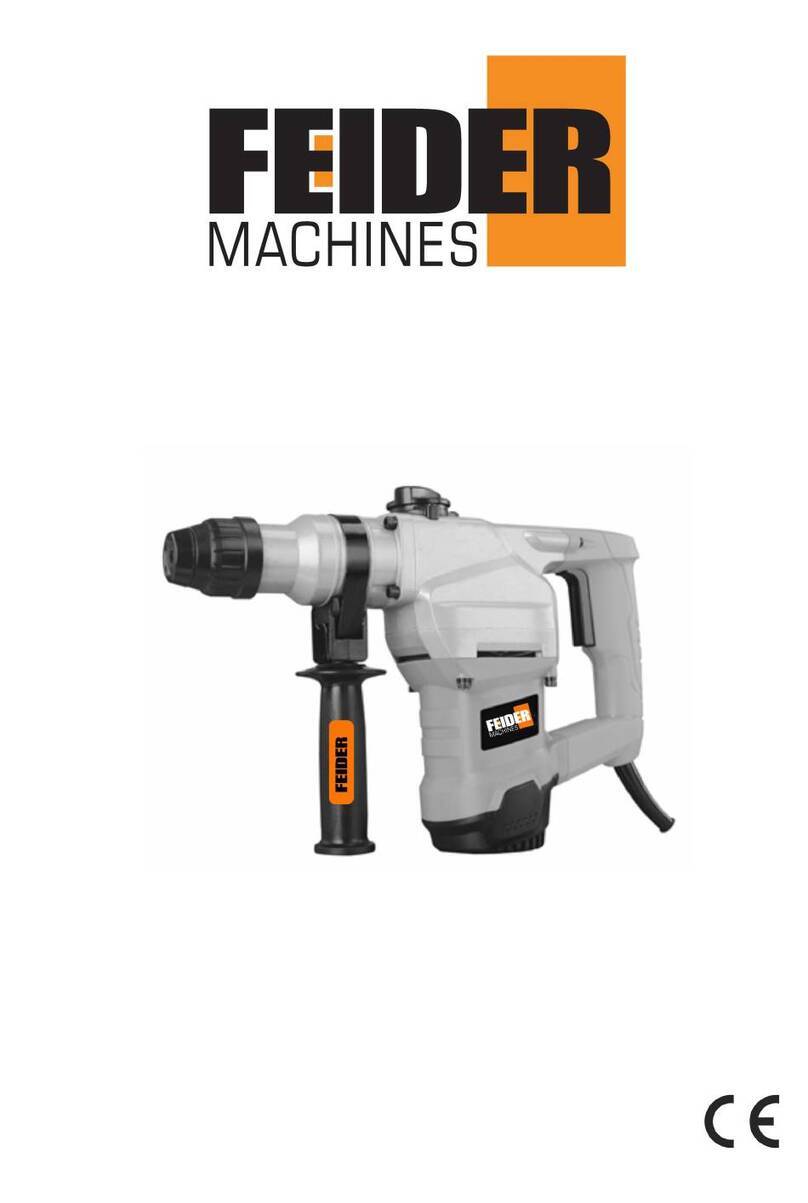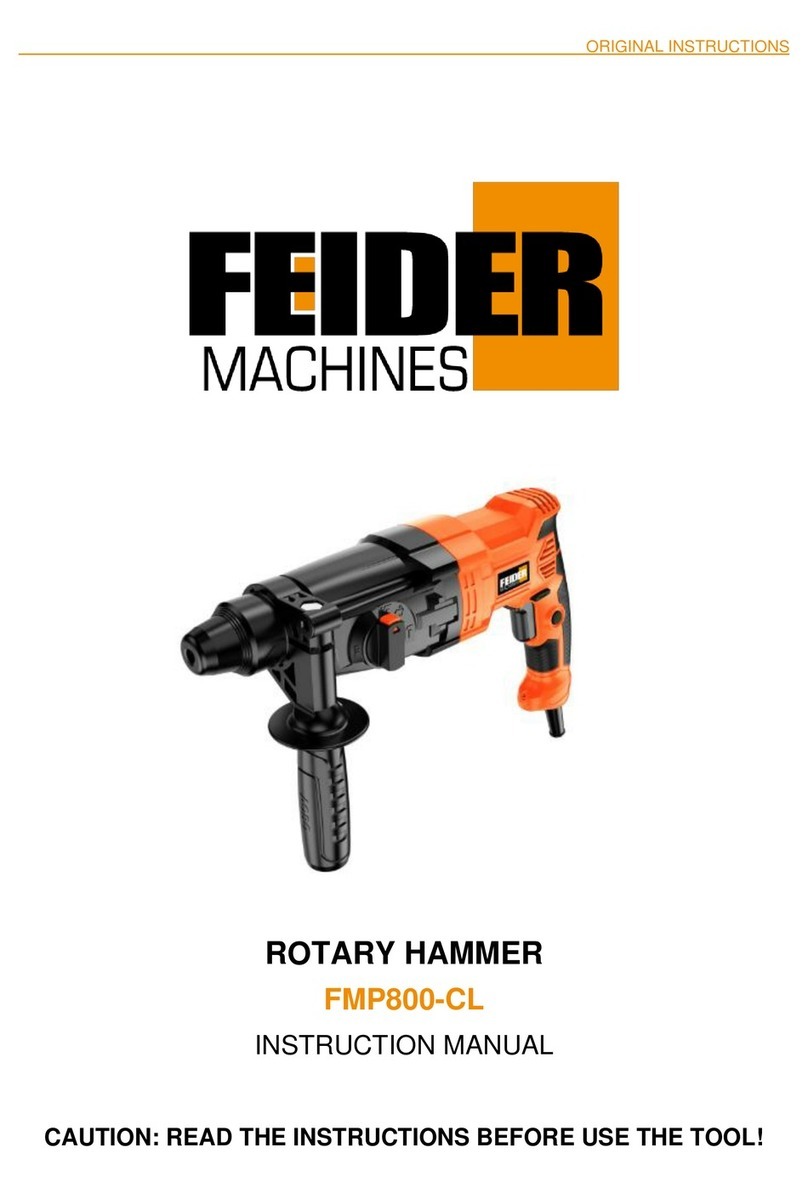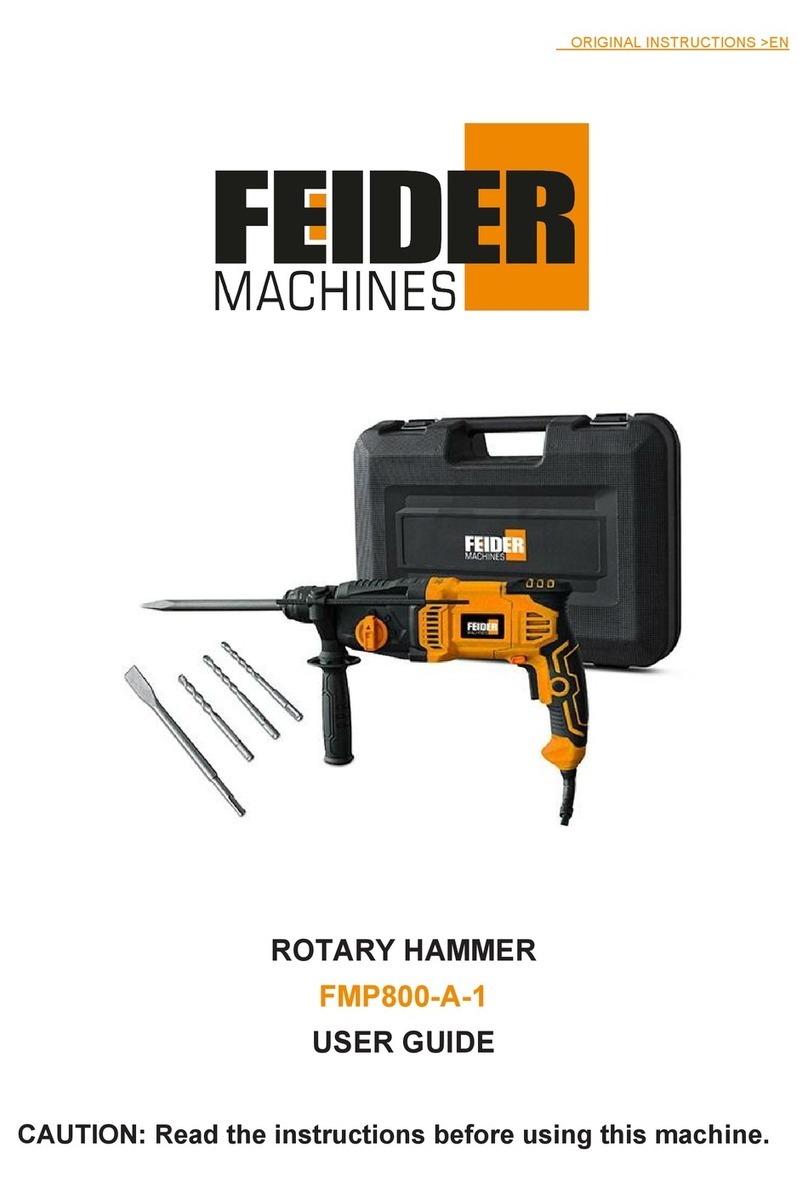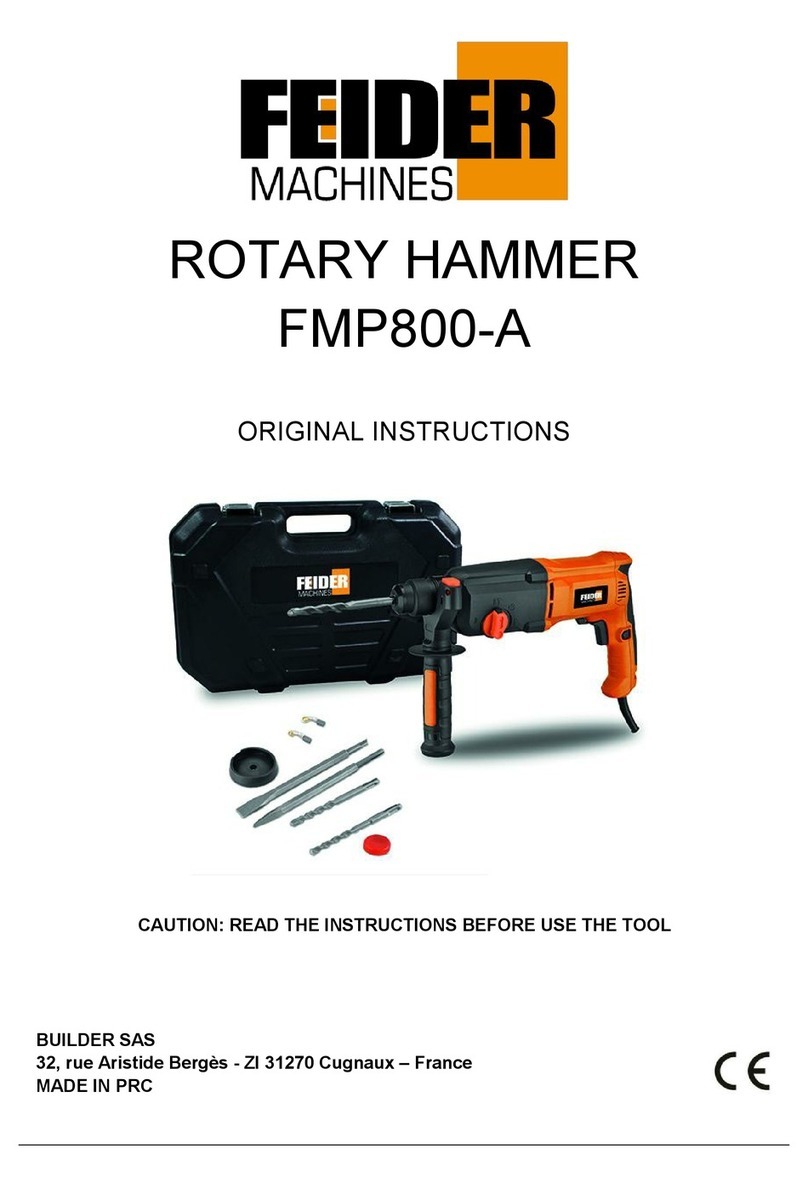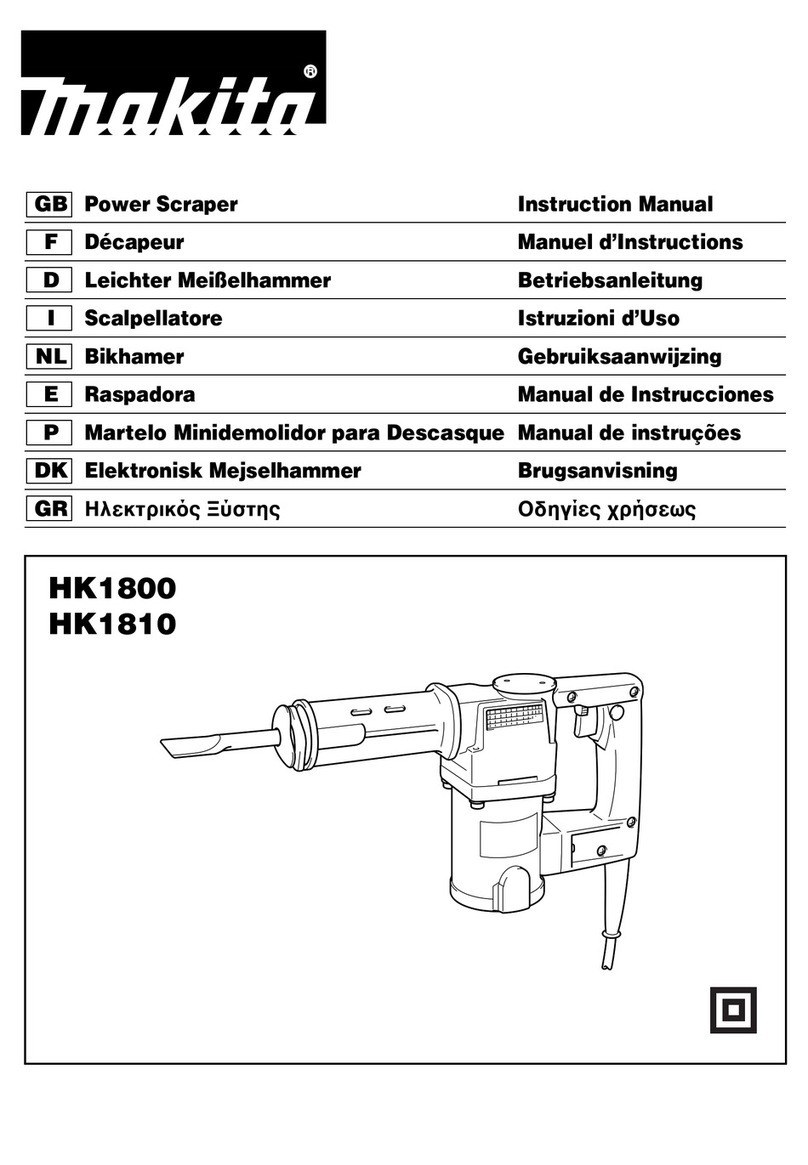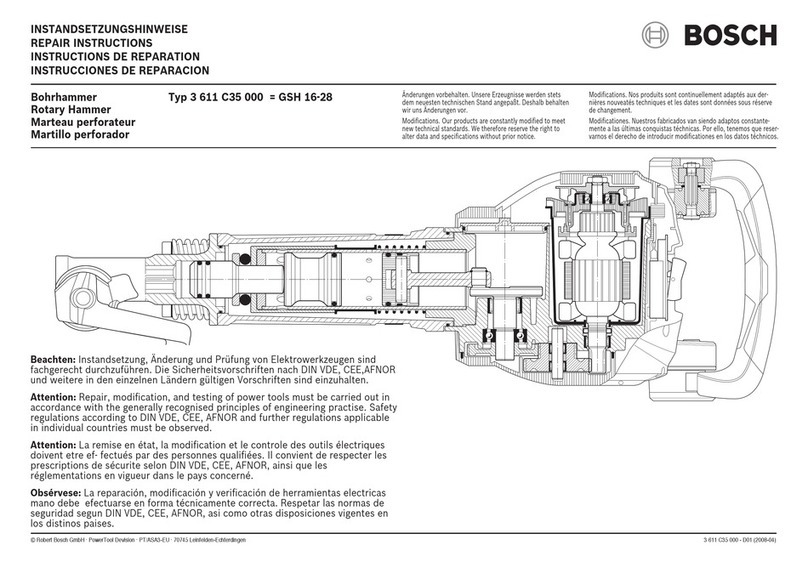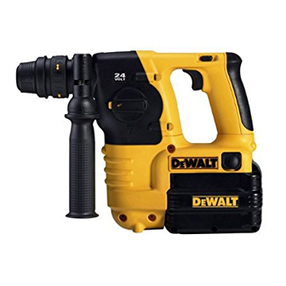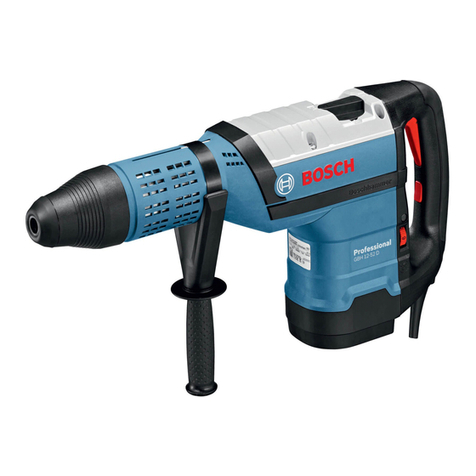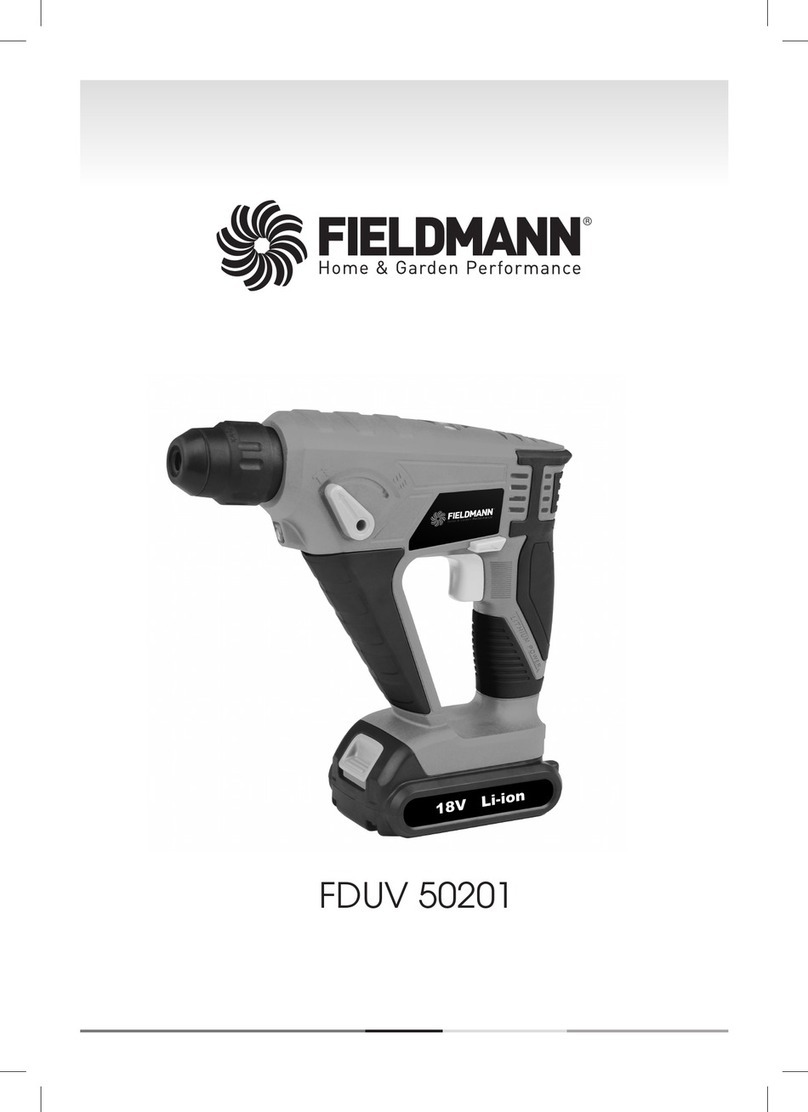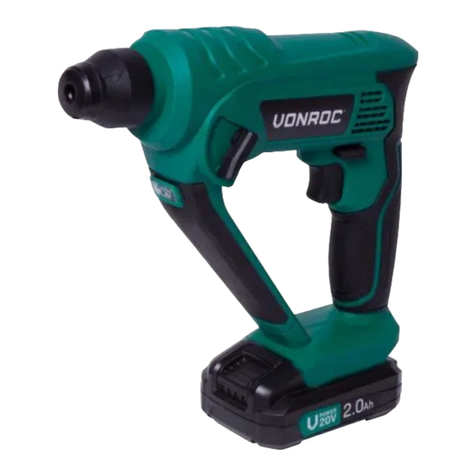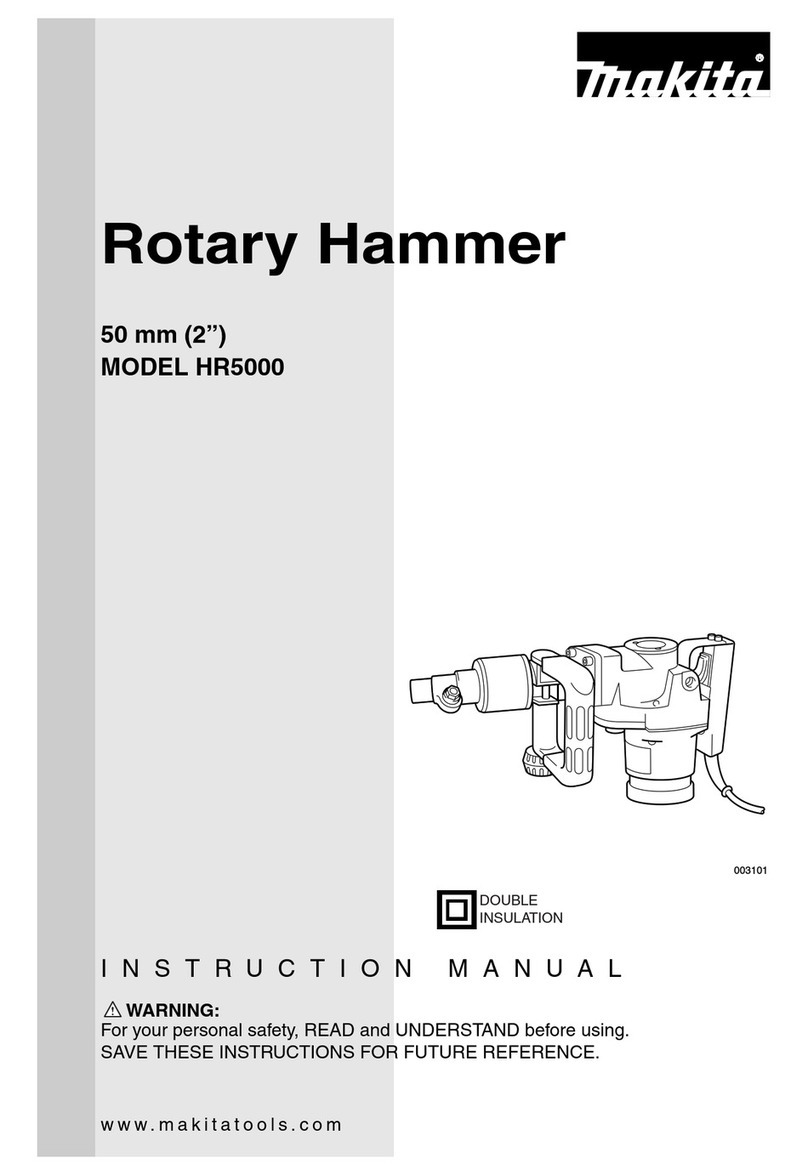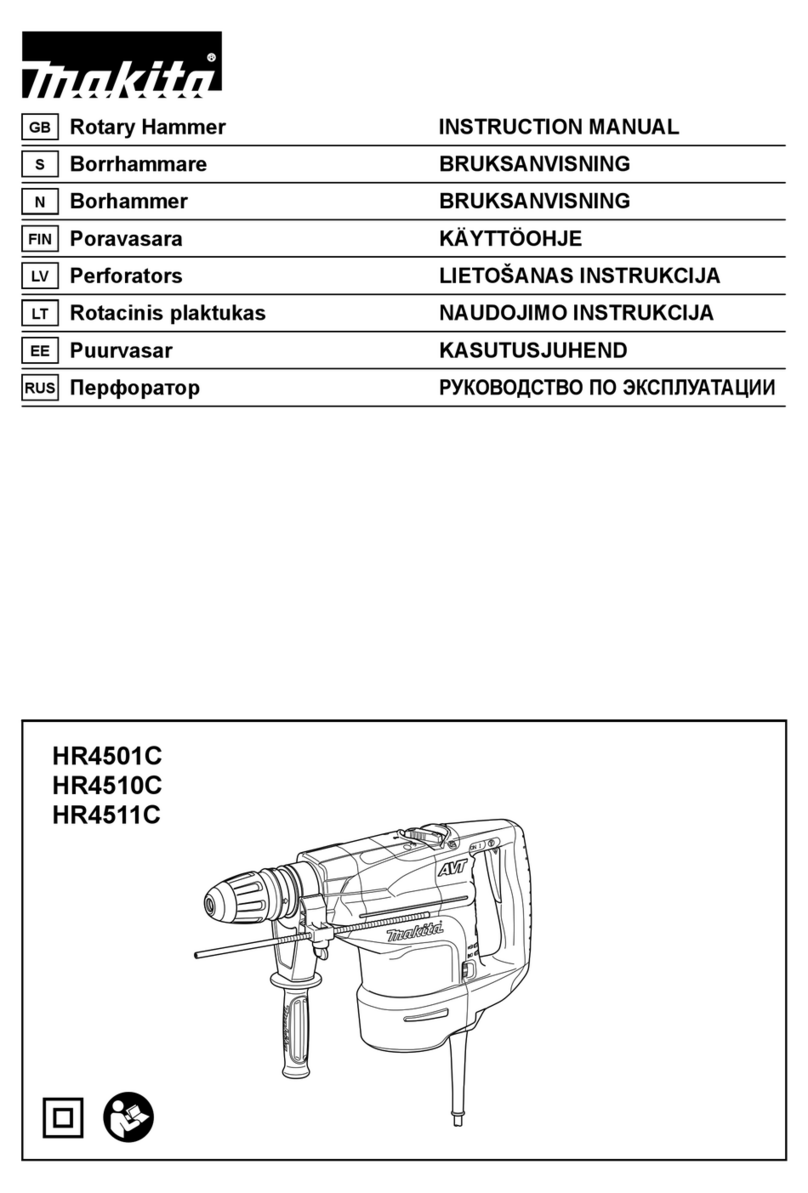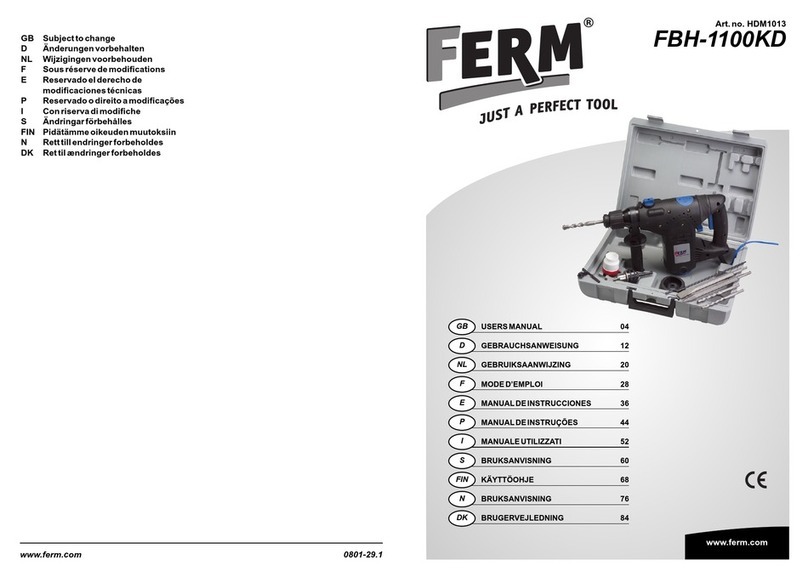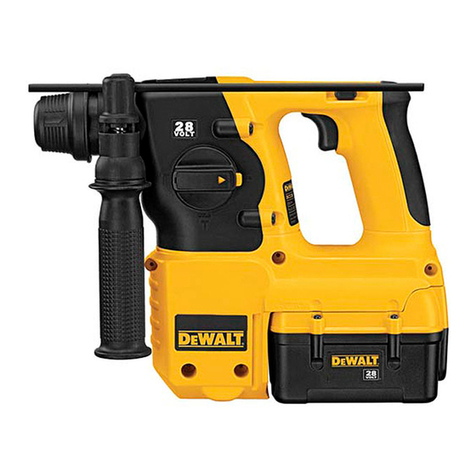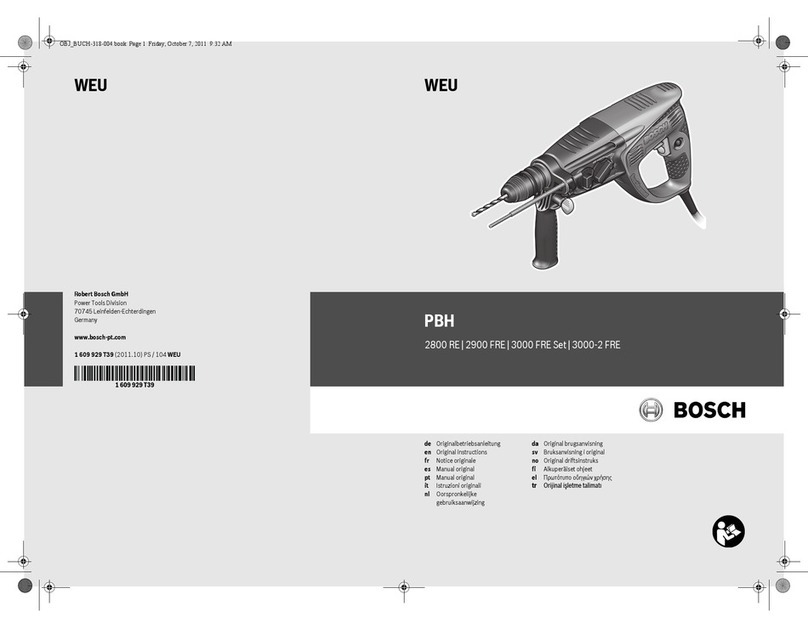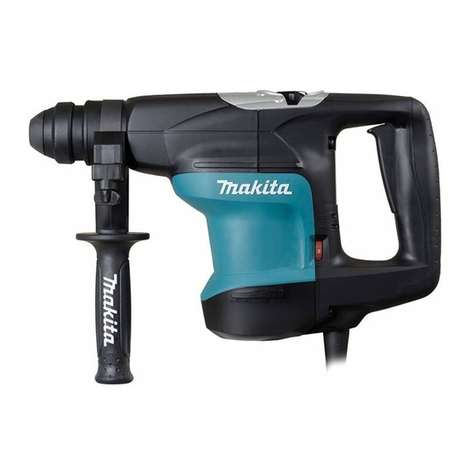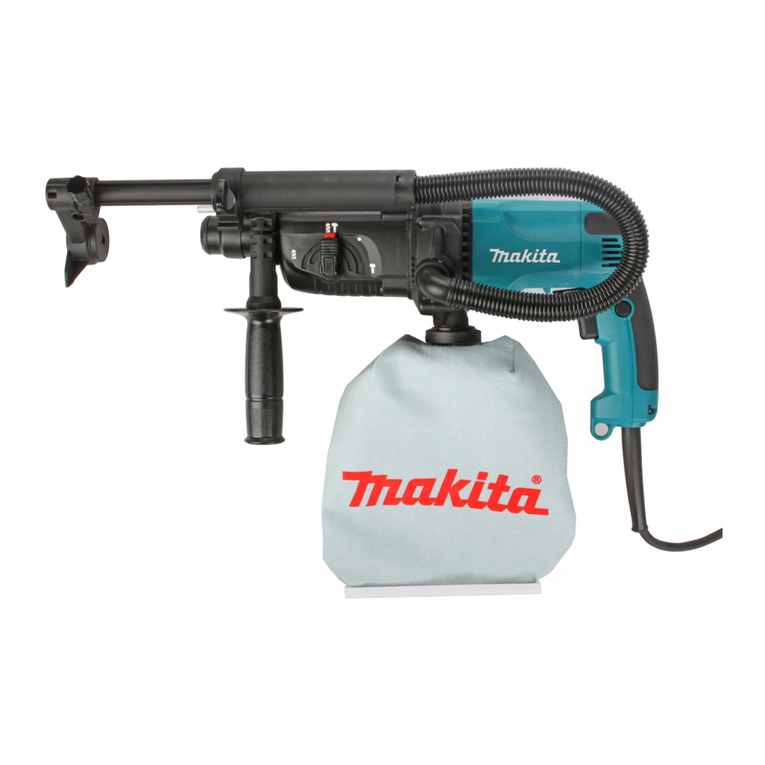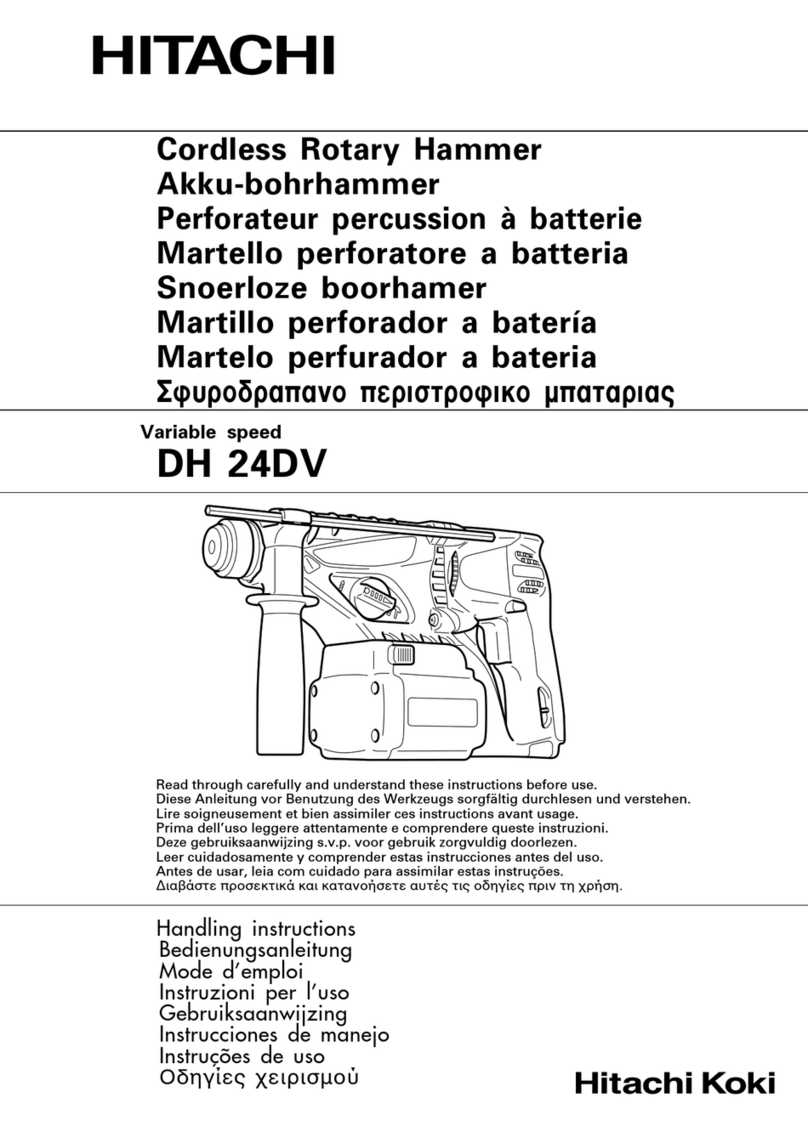Feider Machines FMP800 User manual

ROTARY HAMMER
FMP800
ORIGINAL INSTRUCTIONS
CAUTION: READ THE INSTRUCTIONS BEFORE USE THE TOOL
FEIDER
32, rue Aristide Bergès - ZI 31270 Cugnaux –France

GENERAL TOOL SAFETY WARNINGS
WARNING Read all safety warnings and all instructions. Failure to follow the warnings and instructions may result
in electric shock, fire and/or serious injury.
Save all warnings and instructions for future reference. The term "power tool" in the warnings refers to your
mains-operated (corded) power tool or battery-operated (cordless) power tool.
1) Work area safety
a) Keep work area clean and well lit. Cluttered or dark areas invite accidents.
b) Do not operate power tools in explosive atmospheres, such as in the presence of flammable liquids, gases or
dust. Power tools create sparks which may ignite the dust or fumes.
c) Keep children and bystanders away while operating a power tool. Distractions can cause you to lose control.
2) Electrical safety
a) Power tool plugs must match the outlet. Never modify the plug in any way. Do not use any adapter plugs with
earthed (grounded) power tools. Unmodified plugs and matching outlets will reduce risk of electric shock.
b) Avoid body contact with earthed or grounded surfaces, such as pipes, radiators, ranges and refrigerators.
There is an increased risk of electric shock if your body is earthed or grounded.
c) Do not expose power tools to rain or wet conditions. Water entering a power tool will increase the risk of electric
shock.
d) Do not abuse the cord. Never use the cord for carrying, pulling or unplugging the power tool. Keep cord away
from heat, oil, sharp edges or moving parts. Damaged or entangled cords increase the risk of electric shock.
e) When operating a power tool outdoors, use an extension cord suitable for outdoor use. Use of a cord suitable for
outdoor use reduces the risk of electric shock.
f) If operating a power tool in a damp location is unavoidable, use a residual current device (RCD) protected
supply. Use of an RCD reduces the risk of electric shock.
NOTE the term “residual current device (RCD)” may be replaced by the term “ground fault circuit interrupter (GFCI)” or “earth leakage
circuit breaker (ELCB)”.
3) Personal safety
a) Stay alert, watch what you are doing and use common sense when operating a power tool. Do not use a power
tool while you are tired or under the influence of drugs, alcohol or medication. A moment of inattention while
operating power tools may result in serious personal injury.
b) Use personal protective equipment. Always wear eye protection. Protective equipment such as dust mask,
non-skid safety shoes, hard hat, or hearing protection used for appropriate conditions will reduce personal injuries.
c) Prevent unintentional starting. Ensure the switch is in the off-position connecting to power source and/or
battery pack, picking up or carrying the tool. Carrying power tools with your finger on the switch or energizing power
tools that have the switch on invites accidents.
d) Remove any adjusting key or wrench before turning the power tool on. A wrench or a key left attached to a rotating
part of the power tool may result in personal injury.
e) Do not overreach. Keep proper footing and balance at all times. This enables better control of the power tool in
unexpected situations.
f) Dress properly. Do not wear loose clothing or jewellery. Keep your hair, clothing and gloves away from moving
parts. Loose clothes, jewellery or long hair can be caught in moving parts.
g) If devices are provided for the connection of dust extraction and collection facilities, ensure these are
connected and properly used. Use of dust collection can reduce dust-related hazards.
4) Power tool use and care
a) Do not force the power tool. Use the correct power tool for your application. The correct power tool will do the job
better and safer at the rate for which it was designed.

b) Do not use the power tool if the switch does not turn it on and off. Any power tool that cannot be controlled with the
switch is dangerous and must be repaired.
c) Disconnect the plug from the power source and/or the battery pack from the power tool before making any
adjustments, changing accessories, or storing power tools. Such preventive safety measures reduce the risk of
starting the power tool accidentally.
d) Store idle power tools out of the reach of children and do not allow persons unfamiliar with the power tool or
these instructions to operate the power tool. Power tools are dangerous in the hands of untrained users.
e) Maintain power tools. Check for misalignment or binding of moving parts, breakage of parts and any other
condition that may affect the power tool’s operation. If damaged, have the power tool repaired before use. Many
accidents are caused by poorly maintained power tools.
f) Keep cutting tools sharp and clean. Properly maintained cutting tools with sharp cutting edges are less likely to bind
and are easier to control.
g) Use the power tool, accessories and tool bits etc. in accordance with these instructions, taking into account the
working conditions and the work to be performed. Use of the power tool for operations different from those intended
could result in a hazardous situation.
5) Service
a) Have your power tool serviced by a qualified repair person using only identical replacement parts. This will
ensure that the safety of the power tool is maintained.
Hammer safety warnings
- Wear ear protectors. Exposure to noise can cause hearing loss.
- Use auxiliary handle(s), if supplied with the tool. Loss of control can cause personal injury.
- Hold power tool by insulated gripping surfaces, when performing an operation where the cutting accessory
may contact hidden wiring. Cutting accessory contacting a "live" wire may make exposed metal parts of the power
tool "live" and could give the operator an electric shock.
Wear safety helmet, safety glasses and/or face shield. It is also highly recommended that you wear a dust mask
and gloves.
Intended Use
The machine is intended for hammer drilling in concrete, brick and stone, as well as for light chiseling work, it is also
suitable for drilling without impact in wood, metal, ceramic and plastic.
Wear eyes protection
Wear hearing protection

Wear dust mask
Read instructions of use
TECHNICAL DATA
Model
FMP800
Rated voltage
230V~ 50Hz
Rated power input
800W
No load speed
0-1200/min
drilling capacity
26mm
Protection class
A-weighted sound pressure
level - LpA
Hammer drill mode
89.86 dB(A)
Chiseling mode
92.96 dB(A)
Uncertainty - KpA
K= 3 dB(A)
A-weighted sound power
level - LWA
Hammer drill mode
100.86 dB(A)
Chiseling mode
103.96 dB(A)
Uncertainty - KWA
K= 3 dB(A)
Declaration of the vibration
emission values
Hammer drill mode
Main handle: 14.971 m/s²
Auxiliary handle: 12.676 m/s²
Chiseling mode
Main handle: 13.650 m/s²
Auxiliary handle: 10.010 m/s²
Uncertainty K
K= 3 dB(A)
Information:
The declared vibration total value has been measured in accordance with a standard test method and may be used for
comparing one tool with another;
The declared vibration total value may also be used in a preliminary assessment of exposure.
Warning:
that the vibration emission during actual use of the power tool can differ from the declared total value depending on the
ways in which the tool is used; and
of the need to identify safety measures to protect the operator that are based on an estimation of exposure in the actual
conditions of use (taking account of all parts of the operating cycle such as the times when the tool is switched off and
when it is running idle in addition to the trigger time).
Wear hearing protection.

DESCRIPTION
1. Securing screw
2. Key type drill chuck
3. SDS-Plus adapter shank for drill chuck
4. SDS-plus tool holder
5. Locking sleeve
6. Lock ring for rapid-change chuck
7. Rotational direction switch
8. Lock-on button for On/Off switch
9. on/off switch
10. Release button for mode selector switch
11. Mode selector switch
12. Button for depth stop adjustment
13. Depth stop
14. Auxiliary handle
15. Universal bit holder with SDS-plus shank
The accessories illustrated or described are not included as standard delivery.
Assembly

Before any work on the power tool itself, pull the mains plug.
Auxiliary handle
Operate your power tool only with the auxiliary handle
Rotating the auxiliary Handle
The auxiliary handle can be set to any position for a secure and low-fatigue working posture.
Turn the bottom part of the auxiliary handle in counterclockwise direction and swivel the auxiliary handle to the desired
position. Then retighten the bottom part of the auxiliary handle by turning in clockwise direction.
Pay attention that the clamping band of the auxiliary handle is positioned in the groove on the housing as intended for.
Adjusting the drilling depth
The required drilling depth can be set with the depth stop.
Press the button for depth stop adjustment and insert the depth stop into the auxiliary handle.
The knurled surface of the depth stop must face downward.
Insert the SDS-PLUS drilling tool to the stop into the SDS-plus tools holder 3.Otherwise.the movability of the SDS-plus
drilling tool can lead to incorrect adjustment of the drilling depth.
Pull out the depth stop until the distance between the tip of the drill bit and the tip of the depth stop correspond with the
desired drilling depth.
Selecting drill chucks and Tools
For hammer drilling and chiseling ,SDS-plus tolls are required that inserted in the SDS-plus drill chuck .For drilling without
impact in wood, metal ,ceramic and plastic as well as foe screwdriving and thread cutting, tools without SDS-plus are used
(e.g. drills with cylindrical shank ).
Note: Do not use tools without SDS-plus for hammer drilling or chiseling! Tools without SDS-plus and their drill chucks are
damaged by hammer drilling or chiseling.
Changing the key type drill chuck
To work with tools without SDS-plus (e.g. drill with cylindrical shank) a suitable drill chuck must be mounted (key type drill
chuck or keyless chuck, accessories).
Mounting the key type drill chuck
Screw the SDS-plus adapter shank into a key type drill chuck. Secure the key type drill chuck with the securing screw.
Please observe that the securing screw has a left-hand thread.
Inserting the key type drill chuck
Clean the shank end of the adapter shank and apply a light coat of grease.
Insert the key type drill chuck with the adapter shank into the tool holder with a turning motion until it automatically locks.
Check the locking effect by pulling the key type drill chuck.
Removing the Key Type Drill Chuck
Push the locking sleeve toward the rear and pull out the key type drill chuck.
Inserting the Quick Change Chuck
Before inserting, clean the quick change chuck and apply a light coat of grease to the shank end.
Grasp the SDS-plus quick change chuck or the quick change keyless chuck 1 completely with your hand.

Slide the quick change chuck with a turning motion onto the drill chuck mounting until a distinct latching noise is heard.
The quick change chuck is automatically locked. Check the locking effect by pulling the quick change chuck.
Dust protection cap
The dust protection cap largely prevents the entry of drilling dust into the tool holder during operation. When inserting the
tool. Take care that the dust protection cap is not damaged.
A damaged dust protection cap should be changed immediately. We recommend having this carried out by an
after-sales service.
Inserting SDS-plus Drilling Tools
The SDS-plus drill chuck allows for simple and convenient changing of drilling tools without the use of additional tools.
Clean and lightly grease the shank end of the tool.
Insert the tool in a twisting manner into the tool holder until it latches itself.
Check the latching by pulling the tool.
As a requirement of the system, the SDS-plus drilling tool can move freely. This causes a certain radial run out at no-load,
which has no effect on the accuracy of the drill hole, as the drill bit centers itself upon drilling.
Removing SDS-plus Drilling Tools
Push back the locking sleeve and remove the tool.
Inserting Drilling Tools without SDS-plus
Note: Do not use tools without SDS-plus for hammer drilling or chiseling! Tools without SDS-plus and their drill chucks are
damaged by hammer drilling or chiseling.
Insert a key-type drill chuck.
Open the key-type drill chuck by turning until the tool can be inserted the tool.
Insert the chuck key into the corresponding holes of the key type drill chuck ad clamp the tool uniformly.
Turn the mode selector switch to the “Drilling” position.
Removing Drilling Tools without SDS-plus
Firmly hold the retaining ring of the quick change chuck. Open the tool holder by turning the front sleeve until the tool can
be removed.
Turn the sleeve of the key type drill chuck 2 with the drill chuck key in anticlockwise direction until the drilling tool can be
removed.
Operation
Starting Operation
Observe correct mains voltage! The voltage of the power source must agree with the voltage specified on the
type plate of the power too.
Setting the Operating Mode
The operating mode of the power tool is selected with the mode selector switch.
Note: Change the operating mode only when the machine is switched off! Otherwise, the machine can be damaged.
To change the operating mode, push the release button and turn the mode selector switch to the requested position until it
can be heard to latch.

Position for hammer drilling in concrete or stone
Position for drilling without impact in wood, metal, ceramic and plastic as well as for screwdriving and
thread cutting
Vario-Lock position for adjustment of the chiseling position
The mode selector switch does not latch in this position.
Position for chiseling
Reversing the Rotational Direction
The rotational direction switch is used to reverse the rotational direction of the machine. However, this is not possible with
the On/Off switch actuated.
Right rotation: Turn the selector switch for drilling/hammer drilling on both sides to the stop in the position R.
Left rotation: Turn the selector switch for drilling/hammer drilling on both sides to the stop in the position L.
Set the direction of rotation for hammer drilling, drilling and chiseling always to right rotation.
Switching On and Off
To star the machine, press the On/Off switch.
To lock the On/Off switch, keep it pressed and additionally push the lock-on button.
To switch off the machine, release the On/Off switch. When the On/Off switch is locked, press it first and then release it.
Setting the Speed/Impact Rate
The speed/impact rate of the switched on power tool can be variably adjusted, depending on how far the On/Off switch is
pressed.
Light pressure on the On/Off switch results in low speed/impact rate. Further pressure on the switch increases the
speed/impact rate.

Overload Clutch
If the tool insert becomes caught or jammed, the drive to the drill spindle is interrupted. Because of the forces that occur
always hold the power tool firmly with both hands and provide for a secure stance.
If the power tool jams, switch the machine off and loosen the tool insert. When switching the power tool on with the drilling
tool jammed, high reaction torques can occur.
Working Instructions
The chisel can be locked in 36 positions. In this manner, the optimum working position can be set for each application.
Insert the chisel into the tool holder.
Turn the mode selector switch to the “Vario-lock” position (See “setting the operating mode”). Turn the tool holder to the
desired chiseling position.
Turn the mode selector switch to the chiseling position, the tool holder is now locked.
For chiseling, set the rotation direction to right rotation.
Inserting screwdriver bits
Apply the power tools to the screw/nut only when it is switched off .Rotating tool inserts can slip off.
To work with screwdriver bits, a universal bit holder with SDS-plus shank (accessory) is required.
Clean the shank end of the adapter shank and apply a light coat of grease.
Insert the universal bit holder with a turning motion into the tool holder until it automatically locks.
Check the locking effect by pulling the universal bit holder.
Insert a screwdriver bit into the universal bit holder. Use only screwdriver bits that match the screw head.
To remove the universal bit holder, pull the locking sleeve 6 toward the rear and remove the universal bit holder 15 out of
the tool holder.
Maintenance and cleaning
Before any work on the power tool itself, pull the mains plug.
For safe and proper working, always keep the power tolls and the ventilation slots clean.
A damaged dust protection cap should be changed immediately. We recommend having this carried out by after-sales
service.
If the supply cord is damaged, it must be replaced by a special cord or assembly available from the manufacturer or its
service agent.
Others maintenance and inspection shall be provided by a service agent.

Déclaration de conformité
FEIDER FRANCE
32, rue Aristide Bergès –Z1 31270 Cugnaux - France
Tel : +33 (0)5.34.508.508 Fax : +33 (0)5.34.508.509
FEIDER
ZI, 32, rue Aristide Bergès –31270 Cugnaux –France
Declare that the following tool:
HAMMER
FMP800
Serial number:
Is in conformity with the Directive «machine »2006/42/CE
Also in conformity with the following Directives:
Directive EMC 2014/30/UE
Directive ROHS 2011/65/UE
Also in conformity with the following standards
EN 60745-1:2009+A11:2010
EN 60745-2-6:2010
EN55014-1:2006+A1:2009+A2:2011
EN 55014-2:2015
EN61000-3-2 :2014
EN61000-3-3 :2013
Responsible of the technical file: M. Olivier Patriarca
Cugnaux, 26/11/2018
Philippe MARIE / PDG

Table of contents
Other Feider Machines Rotary Hammer manuals
